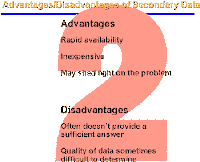- According to Oxford Dictionary, data represent facts or information used in deciding or discussing sth.
Types of Data:
- Data can be classified into two parts: primary data and secondary data.

Primary Data:
- "Primay data are facts and figures that are newly collected for the project."
Primary data collection methods:
Secondary Data:
- "secondary data are facts and figures that have already been recorded before the project at hand." They "re-used" by researchers . Those data has already been published by others, such as U.S.Bureau of the Census or Statistics Cananda.
- Tips: Usually, researchers collect secondary data before gathering primary data.
Forms of Secondary Data:
Qualitative research collects sources from biographies, diaries, newspapers, letters, and ect.
Example: Recently I writed an assignment about a leader in the community profile. I searched many information from newspapers and his biography. By gathering secondary data about his behaviours and characteristics, I understood better about his achievements and why he is so successful.
Quantitative research collects sources from published statistics (ie: Census), government planning documents, international institutions, and etc.
Example: Our group project is to find a appropriate location for a restaurant in North Shore. We would like to find that how many people have lived in North Shore. We also interested in their average income per family.
Internal Secondary Data has been compiled inside the organization for many purposes, which includes financial statements, research reports, customer letters, etc.
 Used into our project: Our client is planning to open a new restaurant in North Shore area. By using internal Secondary Data, we need to find who are our customers (target market). Futhermore, we also need to identify our restaurant's style.
Used into our project: Our client is planning to open a new restaurant in North Shore area. By using internal Secondary Data, we need to find who are our customers (target market). Futhermore, we also need to identify our restaurant's style.
External Secondary Data has been compiled outside the organization for many purposes, which includes government reports, newspaper articles and on-line databases, etc.
 Used into our project: Our mission is to find a right location for a restaurant. Our sources of external secondary data can be wide and varied. As I mentioned before, we would like to find the population in North Shore. We can use internet to find what is the most popular types of restaurant in Vancouver. We may also need to collect information about traffic conditions around North Shore.
Used into our project: Our mission is to find a right location for a restaurant. Our sources of external secondary data can be wide and varied. As I mentioned before, we would like to find the population in North Shore. We can use internet to find what is the most popular types of restaurant in Vancouver. We may also need to collect information about traffic conditions around North Shore.
- Two Major Advantages of Using Secondary Data in Marketing Research:
- Secondary data can be obtained easily and quickly.
- Secondary data is usually less expensive than primary data.
Three Major Disadvantages of Using Secondary Data in Marketing Research: 
- Some secondary information may not available or may even not exist.
- Some secondary data are not accurate and current which may not reflect current market situations.
- Some secondary data can be misleading.

In conclusion, most reserachers agree to use secondary data to save researchers from "reinventing the wheel".
Our gounp would like to use some secondary data combined with other sources in our project.
Yunxia Feng

